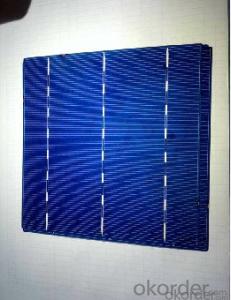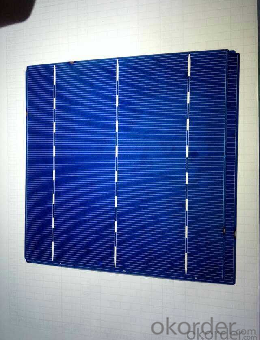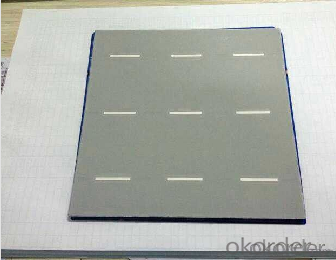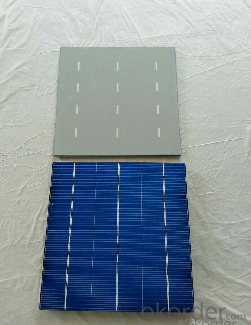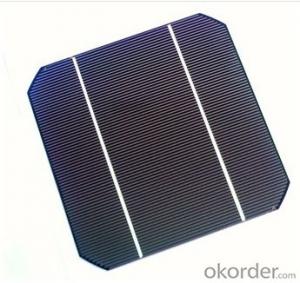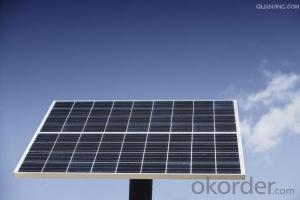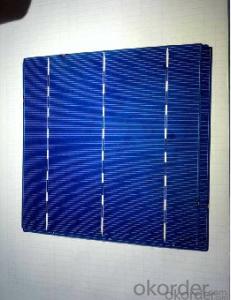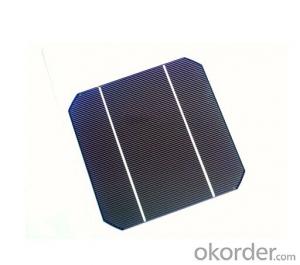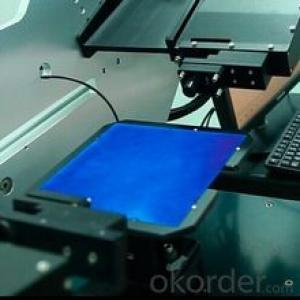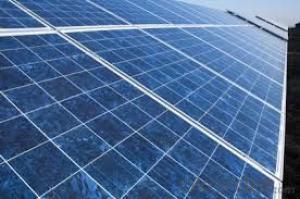Organic Photovoltaic Solar Cells - Poly A Grade CNBM Solar Cells with Different Efficiency
- Loading Port:
- Shanghai
- Payment Terms:
- TT OR LC
- Min Order Qty:
- 100 pc
- Supply Capability:
- 10000000 pc/month
OKorder Service Pledge
OKorder Financial Service
You Might Also Like
Product Description:
Solar cells are often electrically connected and encapsulated as a module. Photovoltaic modules often have a sheet of glass on the front (sun up) side, allowing light to pass while protecting the semiconductor wafers from abrasion and impact due to wind-driven debris, rain, hail, etc. Solar cells are also usually connected in series in modules, creating an additive voltage. Connecting cells in parallel will yield a higher current;our solar cells have passed IEC Certification. With high quality and stable quality. Our Cells can greatly improve the performance of Solar Modules
2.SPECIFICATION:
Efficiency (%) | Pmpp (W) | Umpp (V) | Impp (A) | Uoc (V) | Isc (A) | FF (%) |
18.35 | 4.384 | 0.526 | 8.333 | 0.63 | 8.877 | 78.39% |
18.20 | 4.349 | 0.526 | 8.263 | 0.63 | 8.789 | 78.54% |
18.05 | 4.313 | 0.525 | 8.216 | 0.63 | 8.741 | 78.32% |
17.90 | 4.277 | 0.524 | 8.161 | 0.629 | 8.713 | 78.04% |
17.75 | 4.241 | 0.523 | 8.116 | 0.629 | 8.678 | 77.70% |
17.60 | 4.206 | 0.521 | 8.073 | 0.628 | 8.657 | 77.36% |
17.45 | 4.170 | 0.519 | 8.039 | 0.628 | 8.633 | 76.92% |
17.30 | 4.134 | 0.517 | 8.004 | 0.626 | 8.622 | 76.59% |
17.15 | 4.098 | 0.516 | 7.938 | 0.625 | 8.537 | 76.80% |
17.00 | 4.062 | 0.512 | 7.933 | 0.625 | 8.531 | 76.18% |
16.75 | 4.002 | 0.511 | 7.828 | 0.625 | 8.499 | 75.34% |
16.50 | 3.943 | 0.510 | 7.731 | 0.625 | 8.484 | 74.36% |
3.IMAGES:
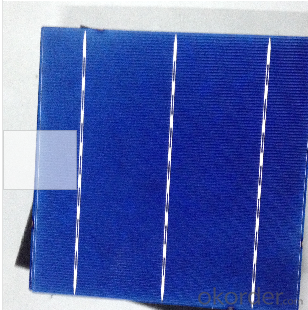
4.Packaging & Delivery of Mono Solar Cells
Carton Box Package and Deliver by air. It should be noticed that it should be avoid of water, sunshine and moist.
5.FAQ:
WHAT'S YOUR ADVANTAGE OF YOUR PRODUCTS?
1. High efficiency and High power.
2. Long-term electrical stability.
3. Lowest price and Fastest delivery.
4. Good quality and best service.
5. Bulk supply
6. Trusted Warranty
7. Big Sale
8. More than 25 years on the lifetime.
- Q: Can solar cells be used for water desalination?
- Yes, solar cells can be used for water desalination. Solar energy can be harnessed by solar cells to power the desalination process, typically through either photovoltaic or solar thermal technologies. This enables the conversion of seawater or brackish water into fresh water by removing the salt and other impurities, making solar-powered desalination a sustainable and eco-friendly solution for addressing water scarcity in coastal regions.
- Q: Can solar cells be used for powering telecommunications towers?
- Yes, solar cells can be used for powering telecommunications towers. Solar panels can generate electricity by converting sunlight into usable energy, which can then be used to power various devices and infrastructure, including telecommunications towers. This renewable energy source provides a sustainable and environmentally friendly solution for powering such towers, especially in remote or off-grid areas.
- Q: What is the maximum efficiency possible for a solar cell?
- The maximum efficiency possible for a solar cell is currently around 46%.
- Q: Can solar cells be used in military applications?
- Yes, solar cells can be used in military applications. They can provide a reliable and sustainable source of power for various military equipment and operations, such as powering communication systems, surveillance devices, and remote military outposts. Solar cells offer the advantage of being lightweight, portable, and environmentally friendly, making them well-suited for military use in remote or off-grid locations. Additionally, solar power reduces the dependence on traditional fuel sources, minimizing logistics challenges and enhancing operational effectiveness.
- Q: Can solar cells be damaged by hail or other weather conditions?
- Yes, solar cells can be damaged by hail or other severe weather conditions. Hailstones can cause physical damage to the surface of solar panels, resulting in cracks or fractures that may affect their efficiency. Additionally, extreme weather events such as heavy rain, strong winds, or lightning storms can potentially cause electrical and structural damage to solar cell systems. Hence, it is important to consider the durability and resilience of solar panels when installing them in areas prone to such weather conditions.
- Q: Can solar cells be used for powering remote weather stations?
- Yes, solar cells can be used for powering remote weather stations. Solar cells convert sunlight into electricity, providing a sustainable and reliable source of power for remote locations where access to the grid may be limited or non-existent. This makes solar cells an ideal solution for weather stations that require continuous power supply in remote areas.
- Q: What is the current situation and the recent progress space solar cells in China?
- Because the power supply system is one of the important subsystems of the satellites, they need to be configured with a suitable, reliable power subsystem. The proportion of the power subsystem in the whole satellite system is the highest, so the research on the power supply system is very important.
- Q: What is the role of tracking systems in solar cell installations?
- The role of tracking systems in solar cell installations is to optimize the efficiency and output of the solar panels by adjusting their position and angle throughout the day to track the movement of the sun. This allows the panels to capture the maximum amount of sunlight and generate more electricity, increasing the overall performance and effectiveness of the solar cell installation.
- Q: How do solar cells perform in polluted environments?
- Solar cells can still generate electricity in polluted environments, but their performance can be negatively affected. Air pollution, such as smog or particulate matter, can block or scatter sunlight, reducing the amount of light that reaches the solar cells and therefore decreasing their efficiency. Additionally, the accumulation of dirt, dust, or pollutants on the surface of the solar panels can further reduce their performance by obstructing sunlight absorption. Therefore, regular cleaning and maintenance of solar panels are essential to optimize their performance in polluted environments.
- Q: Can solar cells be used in extreme climates?
- Yes, solar cells can be used in extreme climates. While extreme temperatures and harsh weather conditions can affect their efficiency to some extent, solar cells are designed to withstand a wide range of climates. In fact, many solar installations are successfully operating in extreme environments such as deserts, polar regions, and high-altitude areas. Proper design, installation, and maintenance techniques can ensure their optimal performance and durability even in challenging climate conditions.
Send your message to us
Organic Photovoltaic Solar Cells - Poly A Grade CNBM Solar Cells with Different Efficiency
- Loading Port:
- Shanghai
- Payment Terms:
- TT OR LC
- Min Order Qty:
- 100 pc
- Supply Capability:
- 10000000 pc/month
OKorder Service Pledge
OKorder Financial Service
Similar products
Hot products
Hot Searches
Related keywords
